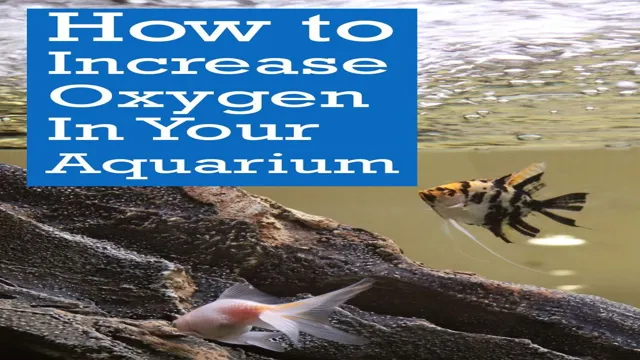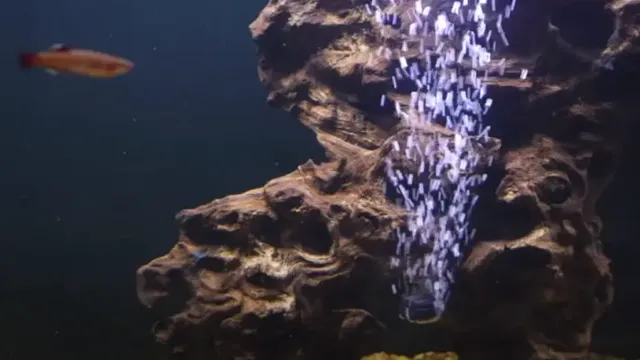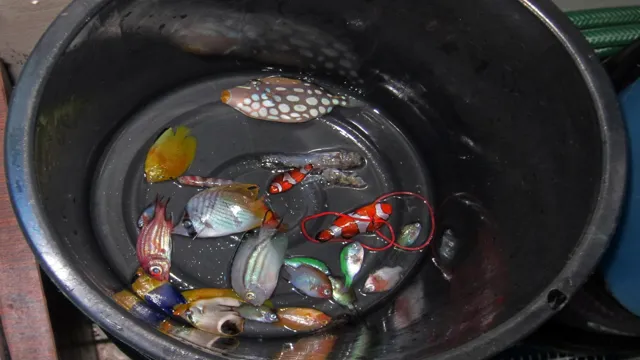As a marine aquarium owner, you know that your fish and other aquatic creatures need oxygen to survive. And that’s why it’s essential to ensure your aquarium has enough oxygen levels. But how do you do that? Do you need to add more water or increase the number of air stones? In this blog post, we’ll discuss ways to increase oxygen in your marine aquarium to keep your underwater pets healthy and happy.
So, let’s dive in!
Why Oxygen is Important
If you’re looking to increase oxygen levels in your marine aquarium, there are a few things you can do to keep your underwater habitat healthy and thriving. Oxygen is essential for the survival of your fish and other marine animals, and it plays a crucial role in maintaining water quality. One way to increase oxygen is by adding live plants, which help to produce oxygen through photosynthesis while also removing harmful nutrients.
You can also increase surface agitation through the use of bubblers, powerheads, or wave makers. This helps to promote gas exchange and keep the water flowing, which in turn increases oxygen levels. It’s important to regularly monitor oxygen levels in your aquarium and make adjustments as necessary to ensure the safety and well-being of your marine pets.
Benefits of High Oxygen Levels in Your Aquarium
One of the essential elements of aquarium maintenance is ensuring that your aquarium has high oxygen levels. Oxygen is vital for the health and wellbeing of your fish and other aquatic creatures. It promotes their metabolism, improves their immune system, helps them digest their food, and boosts their overall growth and development.
Without enough oxygen in the water, your fish may become stressed, lethargic, and susceptible to diseases, which can lead to an unhealthy environment and ultimately, death. Therefore, it’s essential to make sure that your aquarium has proper aeration, filtration, and circulation, to ensure that oxygen is distributed evenly throughout the tank. By doing so, you provide your aquatic pets with a healthy and thriving home.

Factors that Affect Oxygen Levels
If you’re wondering how to increase oxygen in your marine aquarium, there are several factors that can affect oxygen levels in your tank. First and foremost, temperature plays a critical role in oxygen levels as warmer water can hold less oxygen than cooler water. Ensuring your aquarium is well aerated is another key factor as agitation at the water’s surface increases gas exchange.
Making sure your aquarium has the appropriate size pump and filters can help maintain proper oxygenation, while overfeeding and overcrowding can both negatively affect oxygen levels. It’s also essential to keep on top of regular maintenance tasks such as water changes to ensure the overall health and stability of your marine aquarium. By carefully monitoring these factors and making adjustments as needed, you can help increase the oxygen levels in your tank and provide a healthy environment for your marine life.
Temperature and Salinity
Temperature, Salinity, Oxygen Levels Temperature and salinity are two key factors that affect the levels of oxygen in the ocean. Higher temperatures can lead to lower oxygen levels because warm water holds less dissolved oxygen than cold water. Additionally, warmer water temperatures can increase the metabolic rates of marine organisms, causing them to consume more oxygen.
Salinity also plays a role in oxygen levels because saltier water is denser and sinks to the ocean floor. This process, known as “deep water formation,” brings oxygen-rich surface water to the deep ocean, replenishing oxygen levels in the lower layers. However, if salinity levels are too high, it can result in a lack of vertical mixing and a decrease in oxygen levels.
It’s important to consider the effects of temperature and salinity when assessing the health of marine ecosystems, as decreased oxygen levels can have significant consequences for the abundance and diversity of marine life.
Water Movement and Aeration
Water movement and aeration can play a crucial role in maintaining healthy oxygen levels in aquatic environments. There are several factors that can affect the amount of oxygen present in the water, including temperature, pressure, and dissolved organic matter. Higher temperatures generally mean lower oxygen levels, as warmer water can hold less dissolved oxygen.
Likewise, increased pressure can lead to reduced oxygen concentrations due to compression. Dissolved organic matter can also contribute to decreased oxygen levels, as it consumes oxygen as it decomposes. Proper water movement and aeration can help mitigate these factors by introducing fresh air and mixing the water, which can increase oxygen concentrations and improve overall water quality. (See Also: How to Fit Aquarium Tube Filter: A Step-by-Step Guide to Ensure Proper Filtration)
By understanding these factors, aquatic enthusiasts can take steps to maintain a healthy environment for their aquatic life.
Stocking Density
Stocking density is an important factor that affects the oxygen levels within a fish tank or aquarium. It refers to the number of fish or aquatic animals that are present in the tank. When there are too many fish in a tank, the oxygen levels can drop quickly, leading to a variety of problems, such as sluggishness, poor growth, and even death.
Hence, it is vital to maintain a healthy stocking density to ensure sufficient oxygen levels. Factors that can affect oxygen levels include the size of the tank, the number of plants, and the presence of other filtration systems, such as air pumps and water filters. It is essential to monitor stocking density regularly and make necessary adjustments to maintain optimal oxygen levels for the health and well-being of the aquatic life.
Methods for Increasing Oxygen Levels
Do you want to know how to increase oxygen in a marine aquarium? There are several effective methods to help raise oxygen levels and ensure your fish thrive in a healthy environment. One of the most straightforward ways is to install an air pump and an air stone in your tank. This equipment pumps air into the aquarium, causing water movement that helps oxygenate it.
Other ways to increase oxygen include adding live plants, which perform photosynthesis and release oxygen as a byproduct, and using a protein skimmer to remove organic waste that can decrease oxygen levels. It is also essential to maintain your aquarium equipment regularly, such as cleaning the filter and doing regular water changes, as clean water will support healthy oxygen levels. By implementing these methods, you can ensure your delicate marine creatures stay healthy and happy.
Use of Air Stones and Air Pumps
Air stones and air pumps are popular tools used by aquarium owners to increase oxygen levels in their tanks. These devices work by emitting tiny bubbles, which help to aerate the water. One method for increasing oxygen levels is to place an air stone at the bottom of the tank.
As the bubbles rise to the surface, they create circulation, which helps to distribute the oxygen throughout the water column. Another method is to use an air pump to power the air stone. Air pumps come in various sizes and strengths, so it’s essential to choose one that is appropriate for your tank’s size.
An adequately aerated tank is vital for the health and well-being of your fish. Without adequate oxygen levels, fish can become stressed and even die. It’s worth investing in an air pump and air stone to ensure that your tank has the necessary oxygen levels.
With these devices, you can create a tranquil and healthy environment for your fish to thrive in.
Water Movement and Surface Agitation
Increasing Oxygen Levels in Aquariums Maintaining a healthy aquatic environment requires a lot of attention, and one crucial factor is the amount of oxygen dissolved in the water. There are several methods for increasing oxygen levels in aquariums, one of which is increasing water movement and surface agitation. This can be achieved through the use of air pumps and air stones, powerheads, or simply adjusting the water flow from your filter.
The movement of water increases the surface area in contact with the air, allowing for more gas exchange and the diffusion of oxygen into the water. Additionally, the movement of water can help distribute heat and nutrients throughout the tank and promote the growth of beneficial bacteria. It is important to note that excessive water movement can also be harmful to some aquatic creatures.
Still, finding the right balance of oxygen levels and water movement can lead to a healthy and thriving aquarium ecosystem. (See Also: How to Go to Sea Aquarium by Cable Car: A Unique Experience You Can’t Miss!)
Proper Filtration System
If you’re looking to increase the oxygen levels in your aquarium, one of the best things you can do is invest in a proper filtration system. While there are many different types of filtration systems out there, they all share the same basic goal of removing harmful waste and pollutants from the water. By doing so, they not only help to improve water clarity and quality but also increase the amount of dissolved oxygen in the tank.
This is because as the filter removes waste, it also creates surface agitation, which helps to oxygenate the water. Some of the most common types of filtration systems include hang-on-back filters, canister filters, and sponge filters, each with their own unique set of benefits and drawbacks. Ultimately, the best filtration system for your aquarium will depend on factors like tank size, fish species, and personal preference.
However, by investing in a good filter and making use of other oxygenation methods like air stones and powerheads, you’ll be well on your way to creating a healthy, oxygen-rich ecosystem for your aquatic pets to thrive in.
Monitoring and Maintaining Oxygen Levels
If you’re looking to increase oxygen levels in your marine aquarium, it’s important to first establish a baseline measurement. This can be done through regular testing using an oxygen meter. If you find that oxygen levels are low, there are a few steps you can take to address the issue.
First, make sure that there is proper water flow throughout the tank, as this helps to oxygenate the water. Additionally, adding an air stone or powerhead can provide additional aeration. It’s also important to regularly clean your tank to remove any excess organic matter, as this can reduce oxygen levels.
Finally, consider adding live plants to your tank, as they create oxygen through photosynthesis. By taking these steps, you can help to maintain healthy oxygen levels in your marine aquarium and promote the well-being of your fish and other aquatic life.
Testing Your Water Parameters
Oxygen levels are an essential factor when monitoring and maintaining your aquarium’s water parameters. Low oxygen levels can be detrimental to the health of your fish and other inhabitants. To maintain adequate oxygen levels, consider adding an air stone or increasing surface agitation with a powerhead or filter output.
Additionally, regular water changes can help replenish oxygen levels. It’s important to regularly test your water for oxygen levels to ensure they remain within the appropriate range. The main keyword for this topic is “oxygen levels,” which should be monitored and maintained to promote a healthy aquarium environment for all inhabitants.
By taking these steps to keep oxygen levels stable, you’ll be providing a comfortable and healthy environment for your aquatic pets.
Regular Cleaning and Water Changes
When it comes to keeping your aquarium healthy and your fish happy, regular cleaning and water changes are essential. But did you know that monitoring and maintaining oxygen levels is equally important? Oxygen is crucial for the survival of fish and other aquatic animals. Without enough oxygen in the water, your fish could become stressed and susceptible to disease.
You can monitor oxygen levels with a simple test kit or by observing the behavior of your fish. If you notice them gasping at the surface or swimming lethargically, it could be a sign that there isn’t enough oxygen in the water. To maintain oxygen levels, you can aerate the water with a bubbler or air stone, and remove any debris or decaying matter that could consume oxygen. (See Also: How to Lower TDS in Aquarium: 5 Simple Ways to Maintain Water Quality)
A well-aerated aquarium with stable oxygen levels is the key to a healthy and thriving aquatic ecosystem. So, don’t overlook this critical aspect of aquarium care, and keep your fish happily swimming along!
Conclusion and Final Thoughts
So, there you have it, folks! If you want to ensure happy and healthy aquatic life in your marine aquarium, it’s essential to increase oxygen levels. Whether you choose to invest in a high-quality protein skimmer, add air stones, or simply ensure proper water flow, your efforts will pay off in the long run. So why wait? Get to increasing those oxygen levels and watch your marine realm thrive!”
FAQs
Why is oxygen important in marine aquariums?
Oxygen is crucial for the survival of aquatic organisms and the chemical balance in aquariums. Without enough oxygen, fish and other organisms can become stressed or suffocate.
How can I increase oxygen levels in my marine aquarium?
You can increase oxygen levels by adding an air pump, aerator, or powerhead to increase water circulation. Also, adding live plants or breaking the surface tension of the water can help.
What are some signs that there may not be enough oxygen in my aquarium?
Gasping or struggling for air at the surface of the water, lethargy, and loss of appetite may all be signs that there is not enough oxygen in the aquarium.
Can adding too much oxygen harm fish or other organisms in the aquarium?
Yes, adding too much oxygen can cause gas bubble disease or other health complications in fish, so it’s important to maintain a balanced and appropriate oxygen level in the aquarium.
How often should I check the oxygen levels in my marine aquarium?
It’s a good idea to check the oxygen levels regularly, especially if you have a lot of fish or a heavily stocked aquarium. You can use a dissolved oxygen test kit or a probe to measure oxygen levels.
Are there any plants that can help increase oxygen levels in my aquarium?
Yes, certain aquatic plants like Anacharis, Hornwort, and Java Moss can help increase oxygen levels in the aquarium by producing oxygen through photosynthesis.
Can high temperatures affect oxygen levels in my marine aquarium?
Yes, warmer temperatures can lower the amount of dissolved oxygen in the water, so it’s important to monitor water temperature and adjust as necessary to maintain a healthy oxygen level for your fish and other organisms.







